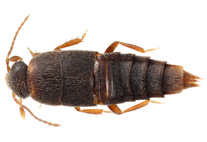Abstract
The complete sequence of the mitochondrial (mt) genome of the assassin bug, Sirthenea flavipes (Stål), was determined. The circular genome is 15, 961 bp long and contains a standard gene complement, i.e., the large and small ribosomal RNA (rRNA) subunits, 22 transfer RNA (tRNA) genes, 13 protein-coding genes (PCGs), and the 1, 295 bp control region. The nucleotide composition of S. flavipes mt genome is 71.8% AT-rich, reflected in the predominance of AT-rich codons in PCGs. Compared with the other three reduviid species available in complete mt genomes, the genome architecture as well as the nucleotide composition, codon usage, and amino acid composition reflected high similarity. All PCGs use standard initiation codons (ATN); however, ND4L and ND1 started with GTG. Canonical TAA and TAG termination codons are found in nine PCGs, the remaining four (COIII, ND3, ND5, and ND1) have incomplete termination codons. All tRNAs have the typical clover-leaf structure, except the dihydrouridine (DHU) arm of tRNASer (AGN) forms a simple loop as seen in many other metazoans. Secondary structure models of the ribosomal RNA genes of S. flavipes are presented and are sim-ilar to those proposed for other insects. The structure of rrnL is more conservative than that of rrnS among sequenced assassin bugs. The monophyly of Reduviidae is highly supported by Bayesian inferences, and the Peiratinae presents a sister position to the Triatominae+ (Salyavatinae + Harpactorinae).
= M�4ie \��Rea Schürhoff, 1937, new synonymy); Neocorvicoana reticulata (Kirby, 1819); Neocorvicoana tricolor (Schürhoff, 1933). Marmarina argentina Moser, 1917 is considered a nomen du-bium until a redescription and illustration of the type specimen facilitates the proper identification of this species. The fol-lowing type specimens were examined: Blaesia atra Burmeister, 1842 (holotype); Gymnetis alauda Burmeister, 1842 (holotype, = G. pantherina); G. bruchi (lectotype, here designated); G. dysoni Schaum, 1844 (paralectotype); G. meleagris Burmeister, 1842 (paralectotype, = G. pantherina); G. perplexa Burmeister, 1842 (holotype, = G. bajula); G. pudibunda (holotype); G. pudibunda porteri Dallas, 1930 (holotype, = G. pudibunda); G. punctipennis Burmeister, 1844 (paralecto-type); G. strobeli Burmeister, 1866 (holotype, = Marmarina tigrina); G. platensis Brèthes, 1925 (holotype, = Heterocotinis semiopaca), G. platensis tandilensis Bréthes, 1925 (holotype, = H. semiopaca); Coelocratus rufipennis (Gory & Percher-on, 1833) (lectotype, here designated); Trigonopeltastes geometricus Schaum in Burmeister & Schaum, 1841 (lectotype, here designated). Four species are endemic to Argentina (G. bouvieri, G. bruchi, G. cordobana, and G. pudibunda), but records of these species might be expected in the Bolivian and Paraguayan Chaco, as well as in Uruguay. Male parameres, armature of the internal sac of the aedeagus, and the general aspects of adults are presented. An additional six species of Cetoniinae bring the total number in Argentina to 36 species: Euphoria lurida (Fabricius, 1775) (Cetoniini); Cyclidius elongatus (Olivier, 1789) (Cremastocheilini); and Inca bonplandi (Gyllenhall, 1817), Inca clathrata clathrata (Olivier, 1792), Inca pulverulenta (Olivier, 1789), and Trigonopeltastes triangulus (Kirby, 1819) (Trichiini). New records in adja-cent countries are four species for Bolivia from a total of 18, 17 of 24 for Paraguay, and two of 10 for Uruguay; 25 species are shared between Argentina and Brazil (three are new records for Brazil).

